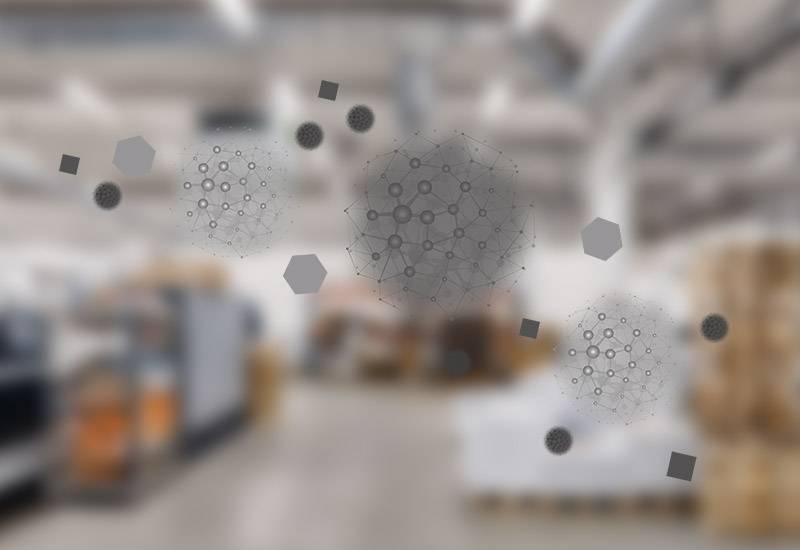Dust has become so normal to us that we often simply ignore it. The problem is, there are types of dust that can be really damaging for our health. Find out all about them here.

Dust looks the same to most people: small, grey, and, in larger quantities, like dark miniature clouds.
But not all dust is the same. Depending on its size and pollutant content, dust can be harmful to our health. This is mainly due to the different types of dust that exist. Here's how it works:
Every material turns into dust through wear and processing. Whether it's rubber, concrete, wood, plastic, or metals. But more on that later.
For simplicity, let's start by distinguishing between two different sizes of dust:
Coarse dust particles
Particles with a diameter of more than 10 µm (1 micrometre is one thousandth of a millimetre) are classified as coarse dust. These particles have direct effects on human health, especially causing cold-like symptoms. The only good thing about this type of dust is that, usually, it is caught by our nose hair when we breathe. Though that’s where the positivity ends for this type of dust
Fine dust
This type of dust is so small and light that it can penetrate deep into the lungs when inhaled. That's why it is also called respirable dust. We refer to it as fine dust when the particles are smaller than 10 µm (remember, 1 micrometre is one thousandth of a millimetre).
So, these are the two size categories. But what different types of dust are there? Which ones are the most dangerous? And why is it worth removing them from your workplace?
1. Concrete dust
During concrete processing, very fine silica dust particles are released into the air. In addition, hall floors are often made of concrete and their abrasion also stirs up tiny particles. Breathing in too much of this dust can have serious consequences. In addition to "less harmful" symptoms like headaches, concrete dust can even cause silicosis. This disease, characterised by thickening or scarring of the lungs, can lead to lung cancer.
2. Wood dust
Most people are familiar with wood dust as sawdust. It is created when wood is sanded, drilled, or sawed. Once airborne, it spreads almost everywhere and forms a thick layer of dust when it settles. Excessive inhalation of sawdust can trigger allergies, among other health issues. However, cancer can also be a consequence.
3. Rubber dust
“Rubber can cause dust?” – Yes! This is a particular problem in logistics. In warehouses and production halls, forklifts and other vehicles create a lot of traffic. Driving around causes natural abrasion of the rubber tires, and the particles are stirred up by the speed of the vehicles, causing airborne rubber dust.
The same principle applies when your building is located near a road, meaning rubber dust often enters the hall from the outside.
The health consequences? Latex, a component of rubber dust, is frequently associated with allergies and asthma. But even more alarming: rubber dust contains extremely toxic chemicals that have been proven to damage human DNA.
If that's not a reason to remove dust from the air, what is?
4. Plastic or fiberglass dust
Although there is not yet sufficient scientific evidence of long-term respiratory diseases associated with excessive inhalation of fiberglass or plastic dust particles, the following observations have been made:
Excessive inhalation of fiberglass or plastic dust particles causes irritation in the throat and neck area. Skin contact can even result in rashes that cause burning or itching.
5. Metal dust
When metal is drilled or ground, the resulting dust spreads generously in the air. Employees who are regularly exposed to it risk at least lung and throat irritation. But as they say, trouble rarely comes alone:
Certain types of metal dust are more harmful than others. Especially metals consisting of cobalt, lead, or nickel – these are highly toxic. It's not enough to just remove the dust from the air. When working directly with these metals, wearing respiratory masks is essential.

You see: Different types of dust can pose serious health risks when they accumulate in the workplace.
And even if your company is not associated with all the types of dust listed above, chances are high that you’re dealing with at least one of these types of dust.
What you cannot change: The fact that dust is created in the first place.
What you can change: Preventing dust from settling permanently, being stirred up, and being inhaled by your employees repeatedly.
At Zehnder Clean Air Solutions, we are dedicated to helping workplaces like yours keep their air free of dust. Why? Because:
To get the ball rolling (or rather, your clean air), we highly recommend booking an initial consultation with one of our air purification experts. It's non-binding and free of charge.